Cuckmere Haven defences
Posted: 9 April 2006 22:36
Taking advantage of the relatively good weather, I took a trip out to Cuckmere Haven, a gap in the chalk cliffs between Eastbourne and Seaford where the Germans would have landed had Operation Sealion been given the go-ahead.
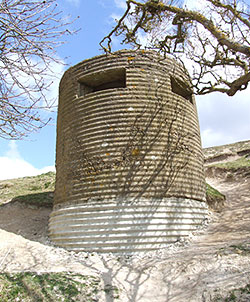
Consulting the Defence of Britain Database - it seems to dictate where I go about the countryside nowadays (a bit like Hitler using his Baedecker guide to determine which British cities to bomb) - I jumped on my bike and headed off.
I've been along this way many times in the distant past, and remember playing in this Type 25 pillbox as a child. (As if any child ever gets to play in it for long before being extracted by parents who want to see something slightly more picturesque; this does assist those who want to take photos without a vocal garrison of three-feet high 'soldiers' though.)
Perched precariously on an eroding slope, this example is listed in the Defence of Britain Project Database and was in danger of collapsing.
However, a new concrete base (corrugated, in keeping with the style) has been used to underpin the pillbox, which is good to see; although most people regard pillboxes as eyesores they are very much worth preserving.
Below is a pair of pillboxes much nearer the coast; another Type 25 and one of an unidentified type. Situated near the base of the east slope of the valley before it begins to rise up into the Seven Sisters, the gap in the cliffs is clearly seen here.
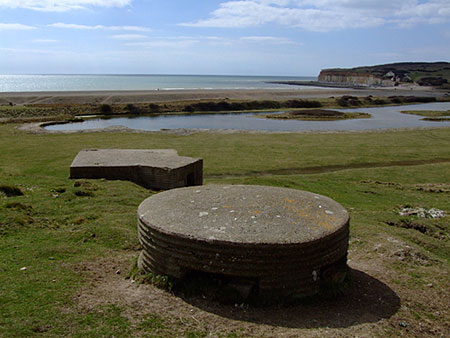
The Type 25 is interesting in that it faces away from the coast, and was obviously intended to protect the rear of its neighbour.
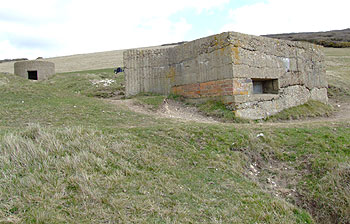
Seen here from the reverse angle, the non-standard type appears to have part of its embrasure bricked up, perhaps to limit its field of fire to allow it to concentrate on a small killing ground.
The rough and hurried construction of this pillbox is indicated by the cracks forming in its walls.
The pillbox is locked up; it may be a roosting site for bats.
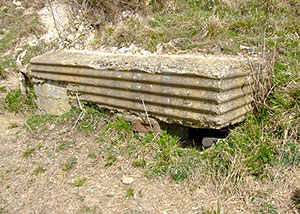
Following the rising ground towards the coast, I stumbled across this odd little pillbox, again, another non-standard type. The entrance is at the left end, with a single embrasure at the right hand corner (the black area.)
This defence is not so easy to see as it's being slowly covered by soil eroding from the slope above it, enhancing its camouflage; hopefully the future of the pillbox won't be threatened by this.
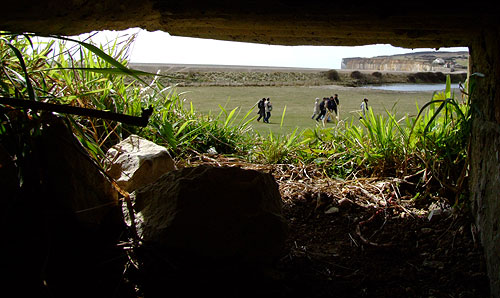
One thing I love about being able to get into pillboxes is to see the view through the embrasures; this effectively indicates why the pillbox was built there by showing what ground the defenders could command. The photograph above shows a group of walkers passing through the field of fire, blissfully unaware that I was shooting them (in the photographic sense!)

This final pair of pillboxes is the closest group to the coast on the east side of the valley. On the left is another non-standard design, similar to the type already mentioned. The type on the right is a Type 23; if you can stand the damp smell, you can enter both.
Had Sealion been launched, these pillboxes were not the place to be; the defenders would have had little hope of surviving the German onslaught. To repel the invader was unlikely; the full brunt of the attack would be concentrated at this point, and the most to be expected from these defences was that they would delay the German advance until reinforcements arrived from further inland.
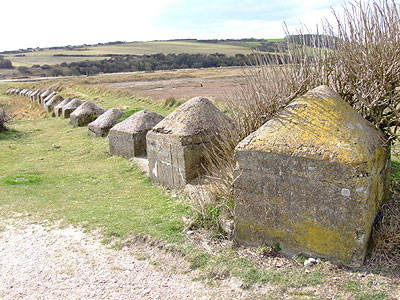
The final obvious defence on the east side of the Cuckmere Valley was this line of anti-tank blocks, with a small pair of concrete blocks to hold a length of rail or other road block on a rough track leading up the valley.
There were twenty in this short line, the line continuing on the west side of the river, in conjunction with an anti-tank wall.
There were other anti-tank ditches in the area; I'll return to get a better idea of them at a later date; the weather forecast for Friday looks good.
In the meantime, the image below shows the defences; the dragon's teeth at left and the five pillboxes on the far side of the valley.
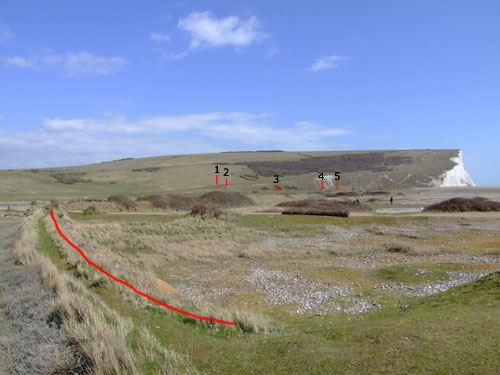
- Pete

Email:
Blog Latest

Bishopstone reveals its pillbox secrets
18 October 2021

Pillbox or Observation Post?
10 June 2020

Uncovering the hidden secrets of a pillbox
8 June 2019

Review of 2018
31 December 2018

Wartime Christmas in East Sussex (2)
24 December 2018
Jargon-buster
Anti-tank ditch
Ditch designed to hinder movement of tanks and AFVs. Ditches could be entirely artificial or existing ditches or natural features such as rivers, might be dredged, shaped and revetted to improve their effectiveness.
Cubes
Anti-tanks blocks, popularly known as dragon's teeth. Not to be confused with smaller blocks known as pimples, cubes can be upwards of 1m square. Many examples in Sussex have apexes or chamfered edges, leading to them being incorrectly recorded as coffins.
Defence of Britain Project
A large project run by the Council for British Archaeology (CBA) 1995-2002, collecting data on 20th century military structures submitted by a team of some 600 volunteers. The result was a database of nearly 20,000 records which is available online. The anti-invasion section of the database contains nearly 500 entries for East Sussex.
Embrasure
A loophole or slit that permits observation and/or weapons to be fired through a wall or similar solid construction.
Pillbox
Generic term for a hardened field defensive structure usually constructed from concrete and/or masonry. Pillboxes were built in numerous types and variants depending on location and role.
Sealion
(German Seel÷we) - Operation Sealion was the code name for the German plan for the invasion of Britain.
Type 23 pillbox
A rectangular pillbox with enclosed compartment for ground defence with an open compartment at the rear for a light anti-aircraft machine-gun.
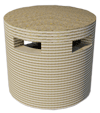
Type 25 pillbox
A small circular pillbox, usually cast in concrete shuttered with corrugated iron. Sometimes referred to as an Armco pillbox after its manufacturer.
This site is copyright © Peter Hibbs 2006 - 2024. All rights reserved.
Hibbs, Peter Cuckmere Haven defences (2024) Available at: http://pillbox.org.uk/blog/216495/ Accessed: 27 July 2024
The information on this website is intended solely to describe the ongoing research activity of The Defence of East Sussex Project; it is not comprehensive or properly presented. It is therefore NOT suitable as a basis for producing derivative works or surveys!